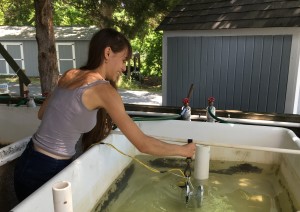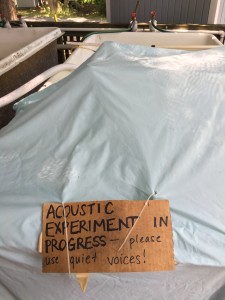
SERC intern Michelle Hauer sets up her soundscape ecology tank experiment (Photo: Emily Li/SERC)
by Emily Li
In high school, Smithsonian Environmental Research Center intern Michelle Hauer fell in love with sound. She discovered the cello, which she insisted on bringing to her internship this summer despite having limited space and housing. But her affair with sound didn’t stop there, even as she was exploring her interest in science. While still in high school, she wrote a paper on the effects of naval sonar on marine mammals. Then, while attending DePaul University, Hauer came across the relatively new field of soundscape ecology through a Chicago-based organization called Chicago Wildsounds—and she hasn’t looked back. Now, as a summer intern in SERC’s Fish and Invertebrate Ecology Lab, Hauer is studying the darker side of sound by researching how noise pollution can affect marine wildlife in the Chesapeake Bay and beyond.
The cockroaches of the sea

A mummichog (Fundulus heteroclitus) (Photo: Robin Baranowski, National Park Service)
At first glance, the mummichog is a small, unassuming olive-brown fish found in estuaries and salt marshes along the Atlantic coast of North America. But among ecologists, the mummichog has a reputation as one of the toughest fish in the sea. Mummichogs can tolerate huge ranges of temperature and salinity, up to three times the salinity of seawater. They’ll survive in low oxygen levels, even if they’re being handled out of the water. They can even withstand the toxins of heavily polluted marine ecosystems. In fact, the mummichog was the first fish ever sent to space in 1973—and they learned to swim in zero gravity.
“I don’t know if they would actually be able to survive a nuclear meltdown like cockroaches can, but I wouldn’t be surprised,” said Hauer with a laugh.
Its incredible hardiness also makes it ideal for scientific research across a variety of fields, from toxicology, to evolutionary biology, to embryology, to chronobiology, the study of circadian rhythms. But as far as Hauer knows, nobody has studied how or if mummichog react to sound—until now.
To that end, Hauer is running an experiment that will investigate mummichog reactions to boat noise pollution. After letting the fish adjust to their new surroundings, she puts one in a tank, plays the boat noise clip for five minutes through an underwater speaker, and records the reaction of the fish with a GoPro. She’s looking for two potential indicators of stress: total movement and opercular beats, which refers to the movement of the bony flap covering the gills and shows how quickly or heavily the fish is breathing.

Intern Michelle Hauer’s experimental tank setup during recording stage (Photo: Emily Li/SERC)
If she does notice a stress reaction, scientists could add noise pollution to the list of stressors that fish already face. And juggling all that stress takes a toll—while short-term stress causes an increase in heart rate, blood pressure, and respiration, chronic stress can negatively impact growth, reproduction, digestion, and even the ability of a fish to fight infection. Only time—and more research—will tell if fish can keep up.
Playing it by ear
Although Hauer has her experiment down pat now, it wasn’t without a couple of speedbumps that forced the scientists to think on their feet. Originally, her project focused only on recording the movements of Atlantic croaker, spot, and white perch. But Hauer and her supervisor, Dr. Erica Staaterman quickly decided recording motion alone wasn’t enough.
“We didn’t think it gave a full enough story to just look at swimming motion,” Hauer explained. “We wanted to include opercular beats in order to give a more accurate and telling story of their stress response.”
Other changes were a matter of their equipment, and nature, refusing to cooperate. Hauer had been excited to study Atlantic croaker because of their sensitivity to sound—until there simply weren’t enough of them showing up in their seine nets, forcing them to switch to mummichogs. She’d been filling the experimental tank with water from the bay—until she looked at the footage and realized the water quality made it impossible to make observations. From the GoPro falling over, to their new water filtration system acting up, to fixing the experimental design itself, Hauer’s research is a testament to how flexible, and patient, scientists often have to be.

SERC intern Michelle Hauer records the data from her last trial (Photo: Emily Li/SERC)
Despite the setbacks, Hauer is pressing on. But this study isn’t the only research she’s juggling this summer. She’s also helping Staaterman conduct another variation of the mummichog project, where they’ll be taking blood samples of the mummichog immediately after the noise playback. This allows them to assess their stress reactions by measuring cortisol, a stress hormone common to vertebrates. In addition, Hauer is analyzing a chorus of toadfish calls Staaterman recorded in Panama, and using a sound-proofed tank to note the calls of fish they’ve caught while seining in the bay. Clearly, she has a lot of questions—and she’s willing to work to get the answers, one study at a time.
“If there’s a lot of boat noise in an area … could it affect the food chain if predators can’t hear their prey, or if prey can’t hear predators approaching? Or if females can’t hear males, could it disrupt their mating patterns?” said Hauer. “That’s not something we can definitively answer with this experiment, but this is the type of thing that’s preliminary to asking those other types of questions.”
Photo of mummichog used under Creative Commons license from Robin Baranowski, National Park Service.

